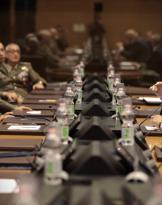Armed conflicts have constituted (and still constitute) one of the main causes of damage and destruction of cultural heritage, because in the strategy of the aggressor the attack on cultural assets is equivalent to the attempt to annihilate the identity and historical memory of the enemy, of whose cultural heritage is a living testimony, thus adding to the material destruction the moral destruction of the enemy1 .
Even the recent chronicles concerning the devastation of important archaeological sites in the various war contexts (although the latter is today almost always "asymmetric", with all that follows, even under the failure to comply with the international legislation set up to protect the Cultural Heritage ) are today's testimony of a real strategy dating back in time (for example, the words of Cato the Elder, according to which “Cartago delenda est"); but it is also true that on other occasions - necessarily referring to the past, from the point of view that will be explained shortly - such destructions were justified by needs of a strictly military nature which, speaking in current terms, responded (or so it was believed) to those criteria of necessity and (military) advantage which later found their regulation both in the Geneva Conventions of 1949 and in the one signed in The Hague on May 14, 1954, having as their object the protection of cultural assets in the event of armed conflict2.
In this sense, of the latter, art. 4, paragraph 1, according to which “The High Contracting Parties undertake to respect cultural property, located both on its own territory and on that of the other High Contracting Parties, refraining from the use of such assets, their protective devices and their immediate vicinity, for purposes that could expose them to destruction or deterioration in the event of armed conflict, and refrain from any act of hostility towards them ";
the next co. 2 of the same art. 4 of the Convention, according to which "The obligations defined in the first paragraph of this article cannot be waived, if not in cases where a military necessity requires, in an imperative way, such a derogation "; or, again, the art. 5, which provides an obligation, even for the above (Contracting Parties), in case of total or partial occupation of the enemy territory, of "support, as far as possible, the action of the competent national authorities of the occupied territory, aimed at ensuring the protection and conservation of their cultural heritage "; as well as the art. 53 of the I Additional Protocol of Geneva which, for its part, states that "Without prejudice to the provisions of the Hague Convention of 14 May 1954 for the Protection of Cultural Property in the Event of Armed Conflict, and other applicable international instruments, it is prohibited: a) to perform acts of hostility directed against historical monuments, art or places of worship, which constitute the cultural or spiritual heritage of peoples; b) use these assets in support of military effort; c) making of these goods the object of reprisals ".
Furthermore, it could affect the art. 6 lett. B) of the II Additional Protocol concerning the protection of Cultural Heritage in the event of armed conflict of the 1999 according to which "in order to guarantee the respect of cultural heritage in accordance with art. 4 of the Convention, (...) a derogation based on the imperative military necessity, according to the art. 4 2 paragraph of the Convention, may be invoked only to use cultural assets for purposes that will likely lead to their destruction or damage when and for as long as there is no other choice between such use of cultural assets and another feasible method for obtaining such a military advantage"; on the contrary, at lett. c) of the same art. 6 states that "a derogation based on the military necessity peremptory, according to the art. 4 paragraph 2 of the Convention, can be invoked only to launch an attack against a cultural asset when and for as long as i) that cultural asset has been made, by virtue of its function, a military objective: and ii) does not exist different feasible alternative to obtain a similar military advantage than directing a hostile act against that objective ".
Precisely in the light of the new principles set out in the current international legislation (which, in addition to the aforementioned Convention, was subsequently integrated also by the II Additional Protocol to the 1999), it would be interesting (by operating a sort of fictio iuris: a criminal law, in fact, cannot dispose that for the future, and nobody can be prosecuted for a fact that, at the time when it was committed, it was not foreseen as a crime to investigate whether the destruction of many sites and cultural interest was, especially during the Second World War, operated secundum legem or, on the contrary, in disregard of it.
Certainly, they cannot fail to remember the "carpet" bombings of cities of art such as Dresden, London and Warsaw, which also demonstrated the substantial ineffectiveness of the then existing legislative instruments: the Regulation attached to the Hague Convention of 18993 and the subsequent Conventions - always signed in The Hague - of 19074.
With reference to our country, instead, in the absence of a systematic bibliographic reconstruction on the subject5, the collective imagination often runs to the dramatic bombing of the abbey of Montecassino, which certainly caused serious damage to the aforementioned, but there were several ancient monuments and archaeological sites struck by the Allies (not only those located within the cities - like the Arch of Augustus in Rimini or the Temple of Augustus in Pula - but also those located in extra-urban areas, such as Pompeii or Hadrian's Villa near Tivoli).
Among the jewels of our cultural heritage, to suffer the war consequences of the Second Conflict, there was also the Real Ferdinando Borbonic Bridge of which, just in recent days, the anniversary of its inauguration (the 10 May 1832 occurred): this structure, located at ford of the Garigliano river, in the immediate vicinity of the ancient Minturnae, was the first suspension bridge built in Europe, designed by Luigi Giura who built it at the behest of Ferdinand II between the 1828 and the 1832.
The bridge "decorated with Pharaonic sphinxes and Egyptising columns"was built with innovative and cutting-edge technology"that for the time seemed a miracle of engineering for the slenderness of the construction and the simplicity of the lines, not lacking in artistic pretension, insinuated and almost closed by a dense wood of eucalyptus"6: the related construction works (which, as mentioned, began in 1828), were strongly discouraged by the opinions of the Body of Engineers of the Kingdom, including Ignazio Stile, who even stamped the typology as retrograde, technological expression of civilization considered by him culturally backward (the reference was to Peru - with the Inca rope bridges - and to the Tibetan bridges of Himalayan China) and that was how it was expressed on the project: "Travelers say that this generation of Ponti is made up by 'Cinesi, and by' Peruani. The first with true chains, and the second with cables. [...] The Chinese, however, and the Peruans, are not the nations the most cradles of the earth, and therefore their products are affected by the weakness of their talents. This is why the Europeans who have long been trafficked in China and Peru, and who have reported the existence of such bridges among us since the very last moment, did not believe that they were well imitated, and neglected them, and put into the issue some things that should not be taken into account [...]"7.
In fact, when the work was completed, nobody was willing to test the futuristic bridge, certain as it was that it would have collapsed under the slightest weight, despite the Jura's reassurances: then, it was the king himself, Ferdinand II (1810-1859) who took the initiative, going to place in the middle of the span and ordering then that two squadrons of trotters and as many as sixteen artillery drawers would pass over it.
The bridge held, at least until the 1943, when the Germans, who had started the famous Gustav Line right from the mouth of the Garigliano (and that, reaching as far as Ortona, in Abruzzo, also passed through Cassino), blew it up: fortunately, the columns ruled and it was rebuilt in the 1998. Currently it is managed (moreover, in an excellent way: a dutiful notation, in contrast to the current scenario - as reported by the media - of a mala gestio of our Cultural Heritage) by the Archaeological Superintendency for Lazio8.
1 R. Mazza, The international protection of mobile cultural heritage in the event of armed conflict: possible developments, in The protection of cultural assets in armed conflicts and disasters, edited by M. Carcione and A. Marcheggiano, Milan, 1997, pp. 265-283, in part. p. 265.
2 «The damage caused to cultural heritage, to any people they belong to, constitutes damage to the cultural heritage of the whole of humanity, since each people contributes to world culture»: This is the beginning of the aforementioned Convention which still constitutes the primary source of legislation for the protection of cultural assets in time of war. This is a significant statement of principle, which contains the ratio inspiring the normative text in question and, at the same time, it marks the conceptual evolution of the matter: with it, in fact, the traditional statist approach to the protection of cultural assets is overcome and, abandoning any reference to the public or private nature of the protected assets, it it reaches a universal notion of "the common heritage of humanity", which evokes a commonality of interests, rather than an opposition, between the State in whose territory the asset is found and the aggressor State.
The idea, strengthened by the Hague Convention, is that cultural heritage is an expression of a "superior interest of all humanity" (U. Leanza, The state of the art in the protection of cultural assets in times of war, in "The international community", 3, 2011, pp. 371-388, in part. p. 371) and that in its statute the profile of the property is recessive with respect to that of functionalization, for which the cultural assets are configured as goods destined for collective fruition rather than as public or private property and this characterization represents the "forming" of the reference legislation.
In the genesis of the Convention the Italian State played a decisive role: in this regard, we can mention the avant-projet presented by Italy during the UNESCO General Conference held in Florence in the 1950. On the point v. U. Leanza, The protection of cultural heritage and the concept of the common heritage of humanity, in Writings in honor of Angelo Falzea, vol. III, t. I, Milan, 1991, pp. 469-486, in part. p. 472).
3 It was foreseen here that in the sieges and bombings all precautionary measures had to be taken to save, as much as possible, the buildings dedicated to the cults, the arts, the sciences and to the charity and assistance, the artistic and historical monuments, etc., on condition but that these goods were not used for military purposes and were marked with special and clearly visible signs at a distance, previously communicated to the opposing belligerent power.
4 They included rules on the laws and customs of land warfare and the bombardment of land targets by naval forces, excluding for the first time the right to plunder the belongings of the enemy.
These violations are expressly stigmatized in the London Charter of 8 August 1945, which established the International Military Court of Nuremberg, according to which (Chapter II, article 6 of the Statute of the Court) constitute war crimes, among others, “ the looting of public and private property, free destruction of cities, towns and villages, or devastation not justified by military necessity ". And it is precisely to them (norms) that reference is made in some sentences of the aforementioned (Nuremberg Tribunal) concerning, among other things, the head of the Einsatzstab Reichsleiter Rosenberg, a special unit created mainly to loot and confiscate all the material deemed politically important in countries occupied by German troops.
5 See what reported at the address http://www.engramma.it/eOS2/index.php?id_articolo=1297.
7 See "As an" Overturned Rainbow ". The suspension bridges in the Italian architectural culture of the 19th Century ”, in Proceedings from the XIII TICCIH Congress organized by the Momigliano Institute for Business History - Terni and Rome 14-18 September 2006.
8 The Borbonico Real Ferdinando bridge is inserted in the Archaeological Area of Minturnae- in the province of Latina-, currently directed by Dr. Giovanna Rita Bellini: http://www.archeologialazio.beniculturali.it/it/174/la-sede.
For more detailed official information regarding the activities of the aforementioned (District), you can consult the facebook page: https://www.facebook.com/Minturnae-Comprensorio-Archeologico-10513423415....
 (photo: in color, after the reconstruction, Domenico Iannantuoni and Franco Spinelli / b / w, before the destruction, Web)
(photo: in color, after the reconstruction, Domenico Iannantuoni and Franco Spinelli / b / w, before the destruction, Web)












